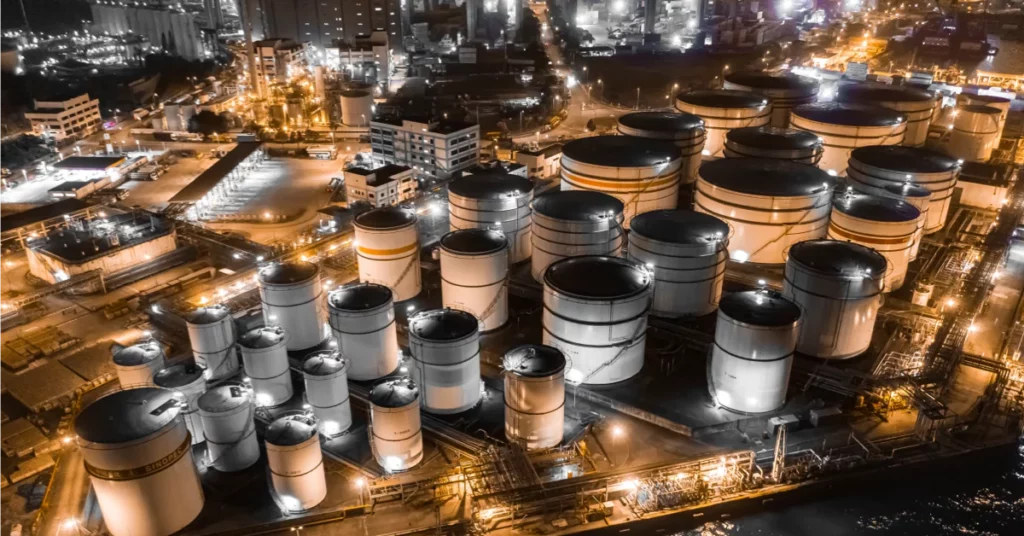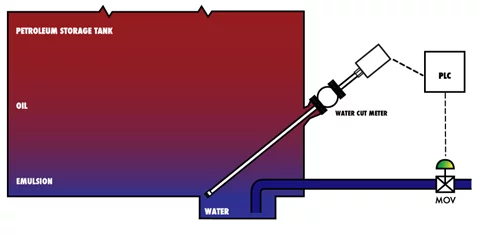Introduction
In the challenging petroleum refining and storage field, managing fluid levels within storage tanks is not just a routine task—it’s a critical operation that impacts both efficiency and environmental safety. Tank dewatering, the process of removing water from crude oil and other stored liquids, plays a pivotal role in maintaining the quality of the stored product and maximizing storage capacity. However, despite its significance, this is often fraught with challenges, ranging from operational inefficiencies to environmental risks.
This article delves into the nuances of tank desalting, addressing vital questions such as how the process works, the selection of appropriate probes, the effectiveness of various systems, and the functional role of these tanks. By exploring these aspects, we aim to comprehensively understand tank desalting and how technological advancements, notably the ID-200 probe, are revolutionizing this essential process.
Understanding Tank Dewatering
Tank dewatering, an essential procedure in the petroleum industry, involves separating and removing water from stored hydrocarbons, whether crude oil or refined products. This process is critical for several reasons:
- It preserves storage capacity, ensuring that tanks can hold maximum volumes of the product.
- It prevents corrosion and damage to the storage tanks, which can be caused by prolonged contact with water.
- And perhaps most importantly, it maintains the quality of the stored hydrocarbons, as excess water can lead to contamination and degradation of the product.
Despite its significance, the process is often beset with challenges. Traditional methods primarily rely on manual observation and intervention and are labour-intensive and prone to inaccuracies. Such inefficiencies can lead to two significant problems: leaving excess water in the tanks, which eats into valuable storage space and causes corrosion, or inadvertently removing hydrocarbons and water, leading to product loss and potential environmental liabilities.
The key to efficient tank desalting lies in accurately detecting and separating the water-hydrocarbon interface within the tank. This is where technology comes into play, offering more precise, automated solutions that enhance the desalting process’s effectiveness and safety.
Choosing the Right Probe for Tank Dewatering
Selecting the appropriate probe for a tank is a decision that hinges on several critical factors. The ideal probe should offer high accuracy and reliability and be suitable for the specific conditions of the storage tanks in use. When it comes to this, accuracy is paramount. To ensure efficient separation, the probe must precisely detect the interface between the water and hydrocarbons. This precision not only maximizes storage capacity but also prevents the loss of valuable hydrocarbons and reduces the risk of environmental pollution.
Reliability is another crucial aspect. The probe should consistently perform under various conditions, including different types of crude oil and varying levels of tank sludge and emulsions. This ensures that the dewatering process remains uninterrupted and effective over time.
Considering these factors, the ID-200 emerges as a leading choice. The ID-200 is engineered to offer precise interface detection thanks to its advanced sensor technology. It can accurately determine the water-hydrocarbon boundary, enabling automation. Its design minimizes the common issues of sensor fouling, often seen in environments with high paraffin or sludge content, thereby maintaining accuracy over prolonged periods.
Moreover, the ID-200 is versatile, with models and configurations adaptable to many tank types and desalting systems. This adaptability allows for tailored solutions, ensuring that the probe meets the specific needs of each storage facility.
The Most Effective Systems for Tank Dewatering
When evaluating the effectiveness of these systems, it’s essential to consider factors such as operational efficiency, accuracy, and environmental compliance. The goal is to find a system that not only effectively separates water from hydrocarbons but also does so in a way that maximizes storage capacity, minimizes manual intervention, and reduces the risk of environmental harm.
Traditional systems often depend heavily on manual monitoring and control, which can lead to inefficiencies and increased labour costs. These systems might need help with accurately detecting the water-hydrocarbon interface, potentially resulting in the unnecessary disposal of valuable hydrocarbons or, conversely, excess water retention in the tank.
In contrast, modern automated systems, especially those utilizing advanced probes like the ID-200, represent a significant leap forward. These systems are designed for precise interface detection, enabling them to automatically start and stop the process based on accurate readings. This automation reduces manual intervention and enhances the operation’s overall efficiency.
The ID-200 system, in particular, stands out for its use of dual-sensor technology. The primary sensor actively monitors the interface, while a secondary sensor serves as a backup and an alarm mechanism in case of primary sensor failure. This dual-sensor approach ensures continuous, reliable operation and provides an added layer of safety against the accidental discharge of hydrocarbons.
Moreover, the flexibility of the ID-200 system allows for customization to fit various tank types and sizes. It can be configured to suit different types of crude oil and varying levels of tank sludge and emulsions, making it a versatile solution for a wide range of dewatering needs.
The most effective tank dewatering systems combine precise, reliable sensing technology with automated control mechanisms. Systems incorporating the ID-200 probe exemplify these qualities, leading to more efficient, safe, and environmentally friendly dewatering operations.
Role and Functionality of a Dewatering Tank
A dewatering tank is crucial in separating water from hydrocarbons in the petroleum industry. Its primary function is to provide a controlled environment where this separation can occur efficiently and effectively. The design of a tank facilitates the settling of water, which is denser, to the bottom of the tank, allowing the lighter hydrocarbons to remain on top. This stratification is critical to this process.
In a typical setup, a dewatering tank will have an inlet for the mixture of hydrocarbons and water and separate outlets for the removed and retained hydrocarbons. The effectiveness of a dewatering tank is significantly influenced by factors like the tank’s design, the nature of the hydrocarbons being processed, and the presence of emulsions or sludge.
Integrating a sophisticated probe like the ID-200 into a dewatering tank system enhances its functionality dramatically. The ID-200’s advanced sensors can accurately detect the interface between water and hydrocarbons, allowing for precise control over the process. This precision ensures that maximum hydrocarbons are retained while effectively removing water, optimizing the tank’s storage capacity and minimizing the risk of corrosion.
Moreover, the automation provided by the ID-200 reduces the need for constant manual monitoring and adjustments. It enables the system to respond dynamically to changes in the interface level, which can vary with different batches of stored liquid. This adaptability is especially beneficial in managing tanks with varying levels of emulsions or sludge, where manual monitoring could be challenging and less reliable.
In conclusion, a dewatering tank is an essential component of the petroleum storage and refining process, tasked with efficiently separating water from hydrocarbons. Incorporating technology like the ID-200 probe enhances the tank’s functionality, improving efficiency, reducing labour costs, and better overall operational safety and environmental compliance.
Real-world Applications and Success Stories
The practical efficacy of the ID-200 automatic tank dewatering probe is best illustrated through its real-world applications and the success stories of various companies that have implemented this technology. These examples demonstrate the probe’s capabilities and provide insights into the tangible benefits it brings to the petroleum industry.
One notable example is a refinery that integrated the ID-200 system into its operations. This move resulted in a significant reduction of hydrocarbons being inadvertently disposed of during the dewatering process. Specifically, the refinery reported an 82% decrease in the amount of hydrocarbons dumped, translating to substantial annual savings and additional profit. This improvement also contributed to better environmental compliance and reduced the risk of penalties associated with hydrocarbon disposal.
Another success story comes from an operator who faced challenges with high levels of emulsions in their storage tanks. The implementation of the ID-200 enabled more accurate detection of the water-hydrocarbon interface despite emulsions, leading to more efficient separation and better maintenance of storage capacity. This not only improved the quality of the stored product but also enhanced the overall operational efficiency of the tank.
These real-world applications underscore the ID-200’s ability to adapt to various challenges encountered in hydrocarbon loss. From reducing environmental liabilities to improving operational efficiencies and product quality, the ID-200 is a valuable asset in the complex petroleum storage and refining landscape.
Conclusion
In conclusion, the challenges of tank dewatering in the petroleum industry demand innovative and efficient solutions. The ID-200 automatic tank dewatering probe represents a significant advancement in this field, offering precision, reliability, and adaptability. By accurately detecting the water-hydrocarbon interface, automating the dewatering process, and reducing the need for manual intervention, the ID-200 enhances operational efficiency, ensures environmental compliance, and optimizes storage capacity.
The success stories from various refineries and storage facilities highlight the ID-200’s impact in real-world scenarios, demonstrating its capability to transform tank dewatering into a more efficient and cost-effective process. With its advanced technology and proven results, the ID-200 is an invaluable tool for any operation looking to improve its tank dewatering system.
We encourage decision-makers in the petroleum industry, refinery management, and related fields to consider the benefits of incorporating the ID-200 into their operations. By doing so, they can expect to streamline their processes and achieve significant long-term savings and environmental benefits. For more information or to explore how the ID-200 can be integrated into your operations, please get in touch with our team of experts.






